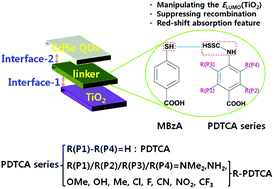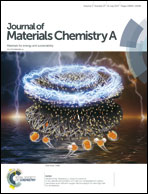Novel bifunctional aromatic linker utilized in CdSe quantum dots-sensitized solar cells: boosting the open-circuit voltage and electron injection†
Abstract
Herein, we theoretically designed and characterized the bifunctional aromatic linker PDTCA utilized in CdSe quantum dot-sensitized solar cells and further modified its benzene ring by varying both its functional groups (NMe2, NH2, OMe, OH, Me, Cl, F, CN, NO2, and CF3) and sites (P1–P4). Via simulating the divided interface-1 (TiO2/linker) and interface-2 (linker/QDs), we found that the substitutions on the P1 and P2 sites of PDTCA by most of these groups could outperform the substitutions on the P3 and P4 sites. On the one hand, these substitutions positively shifted the edge of the unoccupied states of TiO2 towards the vacuum level, favoring a large open-circuit voltage (Voc). On the other hand, it red-shifted the maximum absorption peak (λmax) towards the low-energy region, lessening the hole delocalization from the linker to the QDs and weakening the electron–hole recombination. Overall, the TiO2/linker/CdSe QDs system belongs to a type-II energy level alignment, and the edges of the occupied and unoccupied states of the QDs were insensitive to the variation both of the groups and sites. After excluding the undesired P3 and P4 sites, the electron injection efficiency (ηinj) in the screened groups containing NH2-, Cl-, CN-, and NO2-based TiO2/linker/CdSe QDs systems were calculated. The result showed that the CN-associated systems yielded almost complete electron injection (ηinj ∼ 99%) regardless of the functional site as compared to the picture before the substitution (57%); however, the NH2-, Cl-, and NO2-containing systems produced a site-dependent ηinj pronouncedly. This was attributed to the overwhelming injection rate constant (kinj) as compared to the recombination rate constant (krec) (1013vs. 1010 s−1) in the CN-capped interfaces, whereas in the Cl-, NH2-, and NO2-related systems, the considerable and even larger krec with regard to kinj suppressed the efficient injection. Finally, the CN(P1)-PDTCA and CN(P2)-PDTCA are screened out as the most desired candidates for future application due to their performances favoring a large Voc, lower recombination, a red-shifted λmax, and their ability to boost electron injection.

- This article is part of the themed collection: 2017 Journal of Materials Chemistry A HOT Papers


 Please wait while we load your content...
Please wait while we load your content...